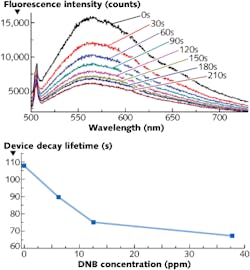An Australian-led group of researchers has enhanced a suspended core microstructured optical fiber with a conjugated-polymer coating to allow sensitive detection of explosives in a liquid volume within the fiber.1 For example, when testing for 1,4-dinitrobenzene (DNB), which is a nitroaromatic explosive, the setup identifies the substance within a few minutes at concentrations as low as 6.3 parts per million (ppm) in a total sampling volume of 27 nl of acetone.
The technique is based on fluorescence quenching of the surface-attached conjugated polymer, which is poly[2-methoxy-5-(2-ethylhexyloxy)-1,4-phenylenevinylene] (MEH-PPV). The small size of the fiber’s core (which is spatially suspended by three links) enables the strong evanescent-field interactions needed for sensing. The team consists of scientists from the University of Adelaide (Adelaide, Australia), the Defence Science & Technology Organisation (DTSO; Edinburgh, Australia), and Shanghai University of Electric Power (Shanghai, China).
The optical fiber is made of a lead silicate glass (Schott F2HT) with a refractive index of about 1.62 and high transmission across the visible region—important for exciting fluorophores with short (477 nm) as well as longer excitation wavelengths; the high refractive-index boosts the fluorescence-capture fraction for very small core sizes. The core diameter was 1.6 μm; the fiber was cut into 20 cm lengths.
To coat the suspended fiber core, polymer was dissolved in tetrahydrofuran (THF) solvent and flowed through the fiber’s air voids using nitrogen at a 20 psi pressure; the fibers were then baked at 75°C for about 8 h to evaporate the solvent, leaving a polymer coating 20 to 40 nm thick on the fiber core and supporting webs. The fiber was then cleaved to a 16 cm length.
Dipping the fiber into a solution fills the fiber via capillary action; the fiber can hold about 17 nL of fluid. For the experiment, light from a 488 nm argonion laser was focused into the fiber core using a 40X microscope objective. The light was chopped at a 1.5 kHz frequency to reduce bleaching of the fluorophore. Spectral measurements were made via a fiber-coupled cooled-CCD spectrometer.
Fluorescence quenching
Readings were taken of a solution of 12.6 ppm of DNB in acetone, as well as of acetone alone as a control. The resulting time-dependent fluorescence spectra show broad emission with a peak at 565 nm, and also include a narrow peak at 510 nm due to Raman excitation of the fiber glass itself (see figure).
Over time (a few minutes), the fluorescence decays due to photo-induced oxidation. The rate of fluorescence decay for DNB in acetone is higher than that for acetone alone, which results from fluorescence quenching by the DNB; this is what indicates the presence and amount of DNB.
An exponential-decay equation was fitted to the data for various DNB concentrations, resulting in a single plot of DNB concentration versus decay lifetime (the exponential equation fits the actual data very closely). The researchers determined that the experimental setup had a detection limit of 6.3 ppm (30 μM). Because their technique does not rely on absolute laser intensity, laser power fluctuations do not affect the measurement.
“Traditionally, explosives detection has involved looking for metals that encase them such as in land mines,” says project leader Georgios Tsiminis, from the University of Adelaide’s Institute for Photonics and Advanced Sensing. “In today’s world, however, homemade improvised explosive devices will often have no metal in them so we need to be able to detect the explosive material itself. This can be difficult, as they often don’t interact with chemicals and we don’t want them near electricity in case they explode.”
Because the technique is so sensitive, forensic investigators could simply take swabbed samples from various surfaces, place them in an organic solvent and, within a few minutes, know if there have been explosives present.
REFERENCE
1. Fenghong Chu et al., Sensors and Actuators B: Chemical, Vol. 199, p. 22 (2014); http://dx.doi.org/10.1016/j.snb.2014.03.031.

